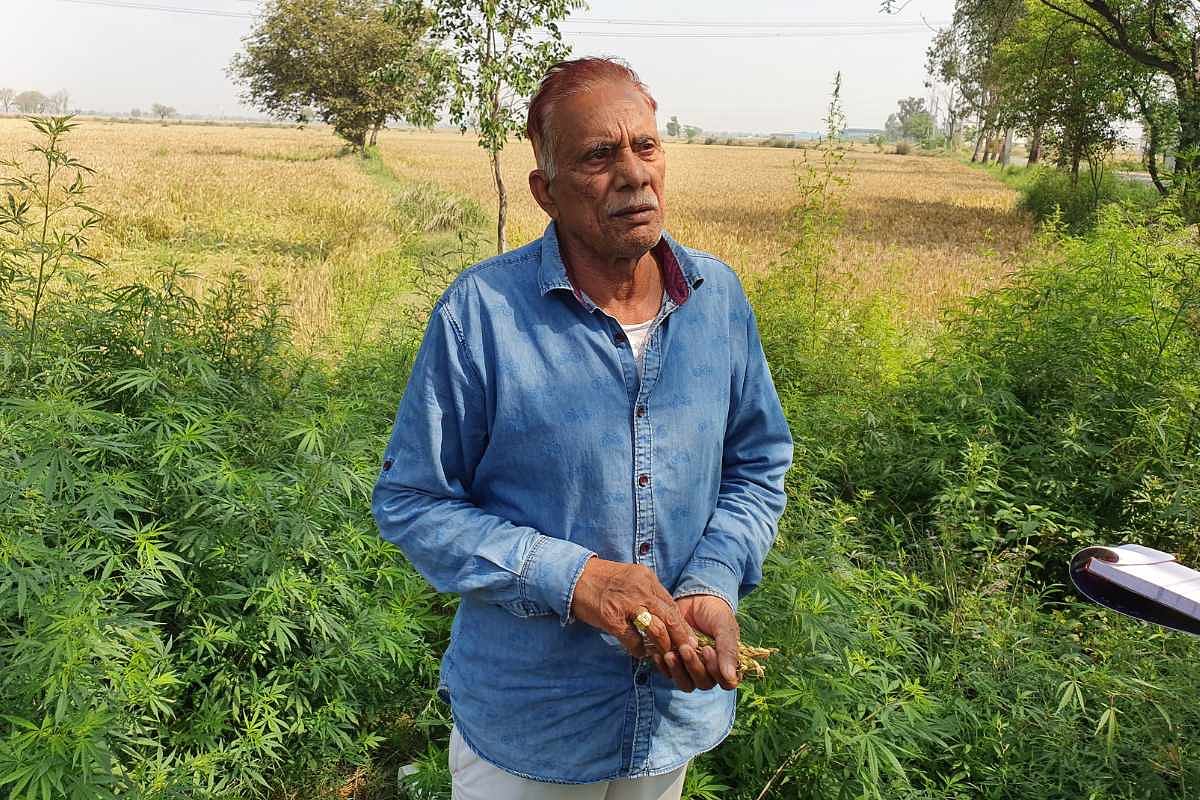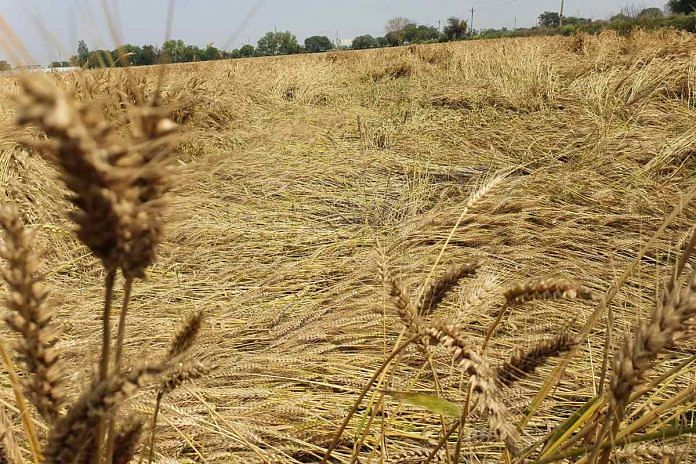Chandigarh: A drive from Gurugram to Jhajjar via Badli shows wheat crops flattened in the fields on either side — a result of intermittent unseasonal rains for the past 12 days which have done extensive damage to crops across the state.
Shiv Kumar, a farmer at Devarkhera village of Jhajjar, plucked some spikes of wheat crop from his fields along the Gurugram-Badli road to show how rains have dented his crop.
“Just see how these spikes are turning black. They are dead now,” he said to ThePrint. “If a plant is flattened for long, the spikes die. There will be no further growth of the grain and they will dry at this size, leading to an overall fall in yield.”
The crop, he said, has become so damp that he will be able to harvest it only after seven days and that too if there is let up in the rain. Harvesting will also be costlier and time-consuming because manual labour is the only way to harvest a crop flattened like this, he added.
According to the state government, farmers can register their crop loss on e-Fasal Kshatipurti portal to avail compensation online. However, the portal says that only those farmers whose villages are verified to have suffered damages can claim compensation.
Haryana Cooperative and Public Health Engineering Minister Dr Banwari Lal said in a press release issued by the State Information and Public Relations Department on Sunday that 1,02,627 farmers have registered 5.73 lakh acres of land on the portal for compensation. ThePrint has a copy of the release.
Official estimates of the losses will only come after field inspections by revenue officials. Insurance companies will also give report based on the crop cutting experiments.
Meanwhile, according to the Indian Council of Agricultural Research’s (ICAR) Indian Institute of Wheat and Barley Research (ICAR-IIWBR), Karnal — the country’s nodal institute that works to improve productivity of wheat — India is on track to achieve its target of 112 million tonnes of wheat this year from its 3.4 million hectares of area under wheat despite widespread lodging, or flattening of crops, in the region.
Speaking to ThePrint Sunday, Gyanendra Pratap Singh, director, ICAR-IIWBR, said, “Lodging of crops alone doesn’t cause much damage to the yield. But if the flattened crop remains underwater for some time, it leads to discolouration of the grain as well as loss of yield.”
He added that farmers should not harvest their crops in a hurry because with the present moisture content they will not be able to sell it in the mandis. “Procurement agencies don’t purchase a crop with over 14 per cent moisture content. Today, the moisture content is as high as 22 per cent. If this wheat is stored, it will rot soon,” he said.
“Farmers who harvest their crops by combine harvesters must wait for at least seven days. Those who get it done manually can do it because the crop can be dried after harvesting too,” he said, though he added that the temperature is not conducive to harvest. A day temperature of 35 degrees Celsius or more is ideal for harvesting but presently, it is 29 degrees Celsius.
Also read: Row over Himachal water cess — how it could help state and why neighbours are against it
No hope of government help
A despondent Kumar said that even last year, he had to purchase wheat for his own consumption despite sowing it in his 24-acre field because it got damaged. There was no compensation.
“A majority of farmers like me are registered under the Pradhan Mantri Fasal Bima Yojana (PMFBY) because we avail crop loans under the Kisan Credit Cards and the banks automatically debit insurance premiums from our accounts,” he said.

“We are not entitled for the relief announced by the (state) government because we are registered under the PMFBY, and the insurance companies have never given me any claim ever since the scheme started,” he added.
Chand Singh, a farmer in Ladpur village of Jhajjar, told ThePrint that his crop is not insured under the PMFBY, but he doesn’t harbour any hopes of getting any compensation from the state government either.
“According to the government, only those who have registered their crop on Meri Fasal Mera Byora portal at the time of sowing can claim compensation,” he said.
“Further, the measly amount farmers get as compensation after making rounds of the offices of patwaris and other officials is not worth the effort,” he added.
Not only in Gurugram and Jhajjar, farmers across Haryana, Punjab and Western Uttar Pradesh have suffered loss of crops.
Suresh Kumar Gahlawat, retired additional director, Haryana Agriculture and Farmers’ Welfare Department, said farmers in almost all the 22 districts have suffered losses.
“Lodging is the permanent displacement of the crop from its vertical orientation as a result of stem buckling. This not only results in the reduction of yield due to impact on grain size but also makes the harvesting process difficult,” he said to ThePrint.
He added that the average crop loss ranges from 10 to 25 per cent in different areas of the state, depending upon the rainfall and the geographical conditions. Even the mustard crop has been badly affected by the unseasonal rains, he added.
Also read: How Haryana, UP & MP are leading the way in regulating edtech content in govt schools
State government aid
A press release by the State Information and Public Relations Department on 31 March quoted Chief Minister Manohar Lal Khattar as saying that only those farmers who had earlier registered on the Meri Fasal Mera Byora portal could log their crop loss details on the e-Fasal Kshatipurti portal.
He said some farmers had complained they had not registered on Meri Fasal Mera Byora portal and hence, were not able to log crop damage information on the Kshatipurti portal either. “Taking cognizance of the complaints, now the government has reopened the portal,” Khattar said.
However, when ThePrint tried to log onto the e-Fasal’s Kshatipuri portal, a message in Hindi said that only the farmers whose villages have suffered damage to crops and have been verified by the deputy commissioner can apply for relief, and that those who wanted to apply needed approval from the deputy commissioner or must meet the district revenue officer.
When ThePrint reached Deputy Chief Minister Dushyant Chautala, who also holds the revenue portfolio, Saturday evening via telephone, he said crop loss verification has already been received from 11 districts, and the rest have been directed to expedite the process.
“Special Girdawari (field inspections by revenue officials to assess damage to crops) to assess losses is underway. Farmers have been told to apply for relief on the portal. The portal will open on 3 April,” he said.
Jagraj Dandi, Joint Director (Statistics) in the Agriculture and Farmers’ Welfare Department, said to ThePrint that of the 16.28 lakh farmers in the state, 8-9 lakh are covered under the PMFBY at any given time. “Those covered under the crop insurance will get their claims from the insurance companies on the basis of crop cutting experiments (CCEs) while the others can get claims from the government,” said Dandi.
He added that under the PMFBY, the threshold yield of an insurance unit — normally a village is taken as an insurance unit — is calculated on the basis of last few years’ average yield. The department carries out CCEs at some random fields in the unit to calculate the yield that particular year. The insurance companies then give the difference between the threshold yield and the actual yield as claims.
“Since the entire village is taken as a unit, the insurance companies pay the claims at the same rate to all the insured farmers, irrespective of their actual losses,” said Dandi.
For those not covered under the PMFBY, the government has announced Rs 15,000 per acre for crop loss of 75 per cent and above, and Rs 12,500 per acre for loss of 50-75 per cent. “Farmers apply on the Kshatipurti portal and the information is verified by the revenue department for relief,” said Dandi.
(Edited by Smriti Sinha)



